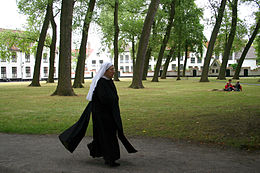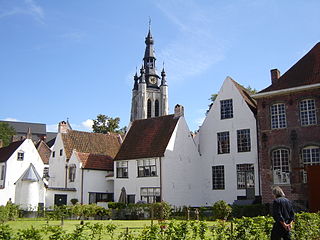
A beguinage, from the French term béguinage, is an architectural complex which was created to house beguines: lay religious women who lived in community without taking vows or retiring from the world.

The Beguines and the Beghards were Christian lay religious orders that were active in Western Europe, particularly in the Low Countries, in the 13th–16th centuries. Their members lived in semi-monastic communities but did not take formal religious vows; although they promised not to marry "as long as they lived as Beguines", to quote an early Rule of Life, they were free to leave at any time. Beguines were part of a larger spiritual revival movement of the 13th century that stressed imitation of Jesus' life through voluntary poverty, care of the poor and sick, and religious devotion.
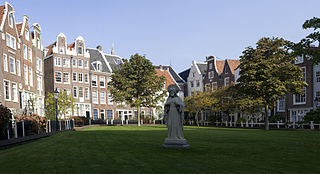
The Begijnhof is one of the oldest hofjes in Amsterdam, Netherlands. A group of historic buildings, mostly private dwellings, centre on it. As the name suggests, it was originally a béguinage. Today it is also the site of two churches, the Catholic Houten Huys and the English Reformed Church.

The Holy Corner or Old Saint Elisabeth is a beguinage in Ghent, Belgium. It is one of three beguinages in the city – the other two are the new Saint Elisabeth beguinage in the suburb of Sint-Amandsberg and Our Lady Ter Hooyen in the Lange Violettenstraat. Both Saint Elisabeth beguinages were named after Elisabeth of Hungary, also known as Saint Elisabeth of Thuringia.
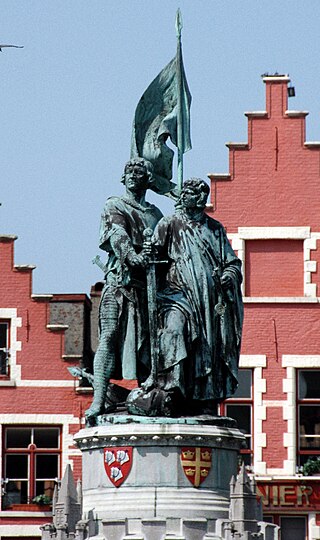
Jan Breydel is credited with leading the Bruges Matins, a violent uprising against Philip the Fair. He is said to have played a major role in the Franco-Flemish War, even though his authenticity has since been questioned.

Herman de Coninck was a Belgian poet, essayist, journalist and publisher.

The Great Beguinage of Leuven is a well-preserved beguinage and completely restored historical quarter containing a dozen streets in the south of downtown Leuven, Belgium. About 3 hectares in size, with some 300 apartments in almost 100 houses, it is one of the largest remaining beguinages in the Low Countries. It stretches on both sides of the river Dyle, which splits into two canals inside the beguinage, thus forming an island. Three bridges connect the parts of the beguinage. The complete beguinage is owned by the University of Leuven and used as a campus, especially for housing academics.

Henri Desclée (1830–1917) and Jules Desclée were Belgian brothers, known as founders of Maredsous Abbey, and of two printing business for Roman Catholic literature, the Société Saint-Jean l'Évangéliste and Desclée De Brouwer.
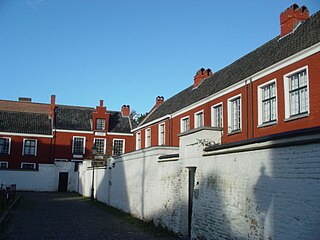
The small beguinage O.L.V. Ter Hooyen is situated in southern area of Ghent. This beguinage was built on the ‘Groene Hooie’, between the ‘Hooipoort’ and the ‘Vijfwindgatenpoort’. That is how this little beguinage got its name.

François-Joseph Kinson, was a Flemish painter.

Bruges is the capital and largest city of the province of West Flanders in the Flemish Region of Belgium, in the northwest of the country. It is the sixth most populous city in the country.

The Exposition des primitifs flamands à Bruges was an art exhibition of paintings by the so-called Flemish Primitives held in the Provinciaal Hof in Bruges between 15 June and 5 October 1902.

Ter Doest Abbey was a Cistercian abbey in Belgium, in the present Lissewege, a district of Bruges, West Flanders.
Auguste Philippe de Peellaert was a Belgian officer who, after his military career, became a painter, composer, and writer.
The following is a timeline of the history of the municipality of Bruges, Belgium.

The Great Beguinage of Sint-Amandsberg is an eight-hectare beguinage in the Sint-Amandsberg suburb, just outside the centre of Ghent, Belgium. It was built between 1873 and 1874 on the abandonment of the Old Saint Elisabeth Beguinage in the city centre. There is also a third beguinage in Ghent, that of Our-Lady Ter Hooyen.
Club Brugge G-Ploeg Recreas is a Belgian disability football club. The team was founded in 2006 and they play their home games and practice on the training fields around the Jan Breydel Stadium.

Emmanuel Viérin is a Belgian painter who belongs to the Belgian Luminist current. He was born in 1869 in Courtrai (Kortrijk), Belgium and died in 1954.


